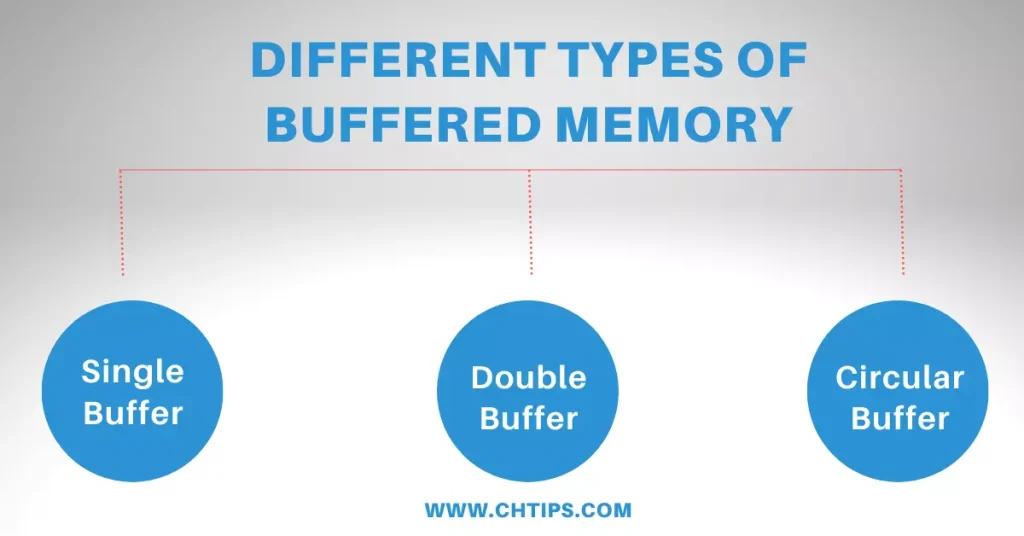
Buffer memory is a type of computer memory. That is installed in the computer system for better functionality and performance.
In a buffered memory system, a hardware register is located between the part of the computer that controls the memory and the memory chips.
It is a device that can hold a certain amount of information at a time.
The registers are filled completely and then it transfers all this information and data in a single instance.
The use of a hardware register indicates that the computer can more reliably control the amount of data and information to be transferred to and from the memory chips at any given time.
There are more advanced versions of buffered memory and their differences.
What is Buffered Memory?
The buffered data is usually stored in RAM for a limited period. The primary task or operation of the buffer is to hold the data before it is utilized and used for further process.
When you download an audio or video file, the computer loads the file in the buffer and then starts to play it when you click the clip.
Then it downloads the remaining clips and stores them in the buffer.
With a clip starting with buffer, it is not from direct internet, so there is less chance of network congestion causing audio or video stalls.
Buffer was used in a computer in different fields to develop software.
The buffer is used to hold the data before it is used. Buffers are commonly used on hard disks to improve data access efficiency.
Send images to the buffer before displaying them on the video card screen (also known as the screen buffer).
A computer program uses a buffer to store data until it is time to play the file. Unless this is a buffer, the computer will run with low skill, and we will wait for too long.
There is a temporary holding area for buffers while they wait to be taken somewhere else.
The outgoing port of transfer for coming data is a concept developed for data conjecture. The buffer is a standard device that is used to improve overall performance.
In terms of data recovery, most of the hardware uses buffers.
Any memory handling and data storage facility uses buffers. CPU functions, even their most basic ones, require buffers to function as registers, where operators, such as data, are stored before being processed.
Buffer is one of the types of computer memory it is at any time to control the electricity going simultaneously in the memory it is designed.
It is made with static memory, but that drives up the cost and slows down the speed at which it works.
The hardware register in the computer system is responsible to controls memory chips in a buffered memory system.
This is a device which is which stores information in a specific quantity. At one time, the register takes the complete information and then gives you all the information simultaneously.
Hardware registers use meaning is a computer at any time how much data can be stored by memory chip, and more strong they control.
One of the major advantages of this system is it takes time to fill the register with data and information.
There will be a delay of only one sixty-six millionth of a second in most PCs. This increases the overall performance and functionality for a long duration.
As a result of performance drawbacks and increasing system hardware prices, the buffered memory is not used in individual computers.
On top of that, it is commonly found in servers used for data processing. Registered memory is the modern term for buffered memory.
These terms are usually utilized mutually. The benefits of dependability surpass the disadvantages of expense and also a complication in these applications.
Nonetheless, you might also see the term “totally buffered memory”.
A slight difference is that each part of the data is buffered, whereas only certain parts are buffered in the standard buffer or registered memory.
The term buffered memory should not be confused with that buffer memory.
Cache memory is sometimes referred to using this term, just like hard drives.
The data is stored in this part of the hard disk.
The information is likely to be accessed repeatedly throughout the computing session, saving time otherwise spent accessing it from the source.
The word or term “buffer memory” does not have any resemblance to cache memory, buffer refers indicates for the place where data and information can be stored, used, and utilized.
Differences Between Buffered and Unbuffered RAM
- DRAM (stores every data as random access memory) and your system memory control (for written DRAM and read involves an argument).
- It has registers used for memory control for low electricity costs, and it makes your memory more static.
- The un-buffered memory is a type of memory with no register between the system memory controller and the DRAM.
- Memory controllers (usually integrated into your motherboard) would now be more efficient than register controllers.
- It has more electrical loss and will have lesser ‘reliability’ on data and information stored.
- It is a memory in the computer.
- There is a register between which DRAM and the system memory controller.
- This is computer memory; there is no register between DRAM and the system memory controller.
- It has more stability to the system, and the system is more stable.
- It is more expensive than unbuffered memory; as we compared to the buffered memory, it is less expensive.
- It is commonly known as registered memory, also called unregistered and conventional memory.
- It is used to give less memory for less electricity.
- It creates an electrical load and a memory.
- It has a high-reliability rate in stored information and less reliability rate in stored data.
- It is used in servers or other important missions that need a stable operating environment. It is used for desktops and laptops, etc.
- It has one clock cycle fewer; it has no clock cycle penalty.
Three Types of Buffers.
- Single Buffer
- Double Buffer
- Circular Buffer
Buffered Memory and Their Differences With Images

Different Types of Buffered Memory
There are 3 types of buffered memory.
- Single Buffer.
- Double Buffer.
- Circular Buffer
1. Single Buffer
It consists of a single buffer system which is used to transfer data and information from one location to another in this buffer system.
There is only one buffer system used to transfer data from one location to another in this buffer.
Whenever a user program requests an I/O operation, data is transferred at that time even when the whole data block is not transferred.
When the system has buffered the entire block, it is transferred to the user program or waited for transfer to the next block.
2. Double Buffer
This is used when there is a need to transfer data from one place to another by using two buffers.
The first buffer is where the I/O data is transferred, the second is where the second buffer is transferred, and finally, the information is transferred to the user program.
3. Circular Buffer
A circular buffer is used when a user needs to receive big blocks of data continuously.
Input/output device data is first transferred to the buffer transfer buffer, after which the second and third buffers are transferred, and after that, is transferred to the last buffer.
This sequence continues until the data is transferred to the user program.
Different Types of Unbuffered RAM
Unbuffered memory is memory with no buffer between the DRAM and the system memory controller.
Using this method, you would be able to directly access your memory controller (normally integrated into your motherboard), and it would be much more efficient than your registered ones.
A battery-powered computer has a higher electrical load and less reliability in storing data.
In a computer system, it is a memory that does not contain a register between the DRAM as well as a system memory controller.
This makes the system less stable. This type of memory is cheaper than buffered memories. This type of memory is also called conventional or unregistered memory.
Such it consumes a higher amount of electricity and generates more memory. This results in less data reliability.
They are used for desktop PCs and laptops. It has no clock penalty.
What is Buffer Memory in Linux?
The buffered data is usually stored in RAM for a limited period.
The primary objective of the buffer is to hold or store the data and information before it is used.
When you download an audio or video file, the computer loads the file in the buffer and then starts to play it when you click the clip.
Then it downloads the remaining clips and stores them in the buffer. With a clip starting with buffer, it is not from direct internet.
So there is less chance of network congestion causing audio or video stalls.
Buffer was used in a computer in different fields to develop software. The buffer is used to hold the data before it is used.
Buffers are commonly used on hard disks to improve data access efficiency.
Send images to the buffer before displaying them on the video card screen (also known as the screen buffer).
A computer program uses a buffer to store data until it is time to play the file.
Where is Buffered Memory Commonly Used?
Buffer memory is commonly used in computers, laptops, and mobile phones that hold the processor’s data.
It is generally written in the main memory in the system without composing memory information is written in the main memory at broadband to the FIFO and after that cleared to slower main memory.
The creation buffer minimizes the processor’s time to write a little block of consecutive data to the main memory.
Related Articles
- Types of Secondary Memory in Computer
- Smallest Unit of Computer Memory
- 12 Examples of Secondary Memory in Computer System
- 4 Functions of Primary Memory in a Computer System
- Different Types of Secondary Memory in Computer System
- Characteristics of Virtual Memory in Computer
- Is Floppy Disk a Secondary Device in Computer Storage
- Differences Between Microsoft Bing and Microsoft Edge
- Differences Between Internal And External Memory
- 13+ Characteristics of Primary Memory
- What is Volatile Storage Devices
- Computer Basic Tutorials
Frequently Asked Questions [FAQs]
Is buffered or Unbuffered RAM Better?
Buffered RAM is more stable than unbuffered memory.
Which is Faster Buffered or Unbuffered
Buffered memory is considerably faster than Unbuffered memory.
Is Registered Memory Better?
Yes, registered memory is far more reliable considered to other memory.
What is DDR3 Unbuffered?
No it is connected directly to the chipset controller.
What is Max Unbuffered?
Max unbuffered memory has the least amount of latency in accessing the RAM,
Get In Touch
I have also written and compiled some articles on computers and telecommunications, and please go through them.
I hope you will like reading it.
I hope that all the questions and queries related to What is Buffered Memory and Their Differences With Examples have been answered here.
Don’t hesitate to contact me, and if you need to add, remove, or update anything from the article, please let me know in the comment section or via email.
I will be more than happy to update the article. I am always ready to correct myself.
I was hoping you could share this article with your friends and colleagues; this motivates me to write more on related topics.
!!! Thank You !!!